The History Of Mazda 626

The Mazda 626 was an automobile produced by Mazda for the export market. It was based on the Japan-market Mazda Capella. The 626 replaced the 616/ 618 and RX-2 in 1979 and was sold through 2002, when the new Mazda6 took over as Mazda's large family car. 4,345,279 of the 626 and Ford Telstar models were sold worldwide.
The 626 was also sold as the Ford Telstar in Asia, Australasia and Southern Africa, but this has been replaced by the European-sourced Ford Mondeo. While in Europe it was always considered a large family car, in North America the first two generations of the 626 were compact cars, and the third, fourth and fifth were mid-size cars.
The 1971 model 616 and 1972 model 618 had been modest successes in the United States, each lasting just a single year. By 1980, the American public was ready for a compact piston-engined Mazda, and the 626 has been a top seller for the marque ever since.
The first Mazda 626 appeared in most markets in 1979. It was a front engined rear wheel drive compact, little changed from the Japan-market Mazda Capella on which it was based. With an 80hp (60kW) 2.0L SOHC straight-4 F/ MA engine, it performed well, with both Consumer Guide and Car and Driver magazines comparing it with a BMW. One innovative feature was a split-folding rear seat, which increased cargo capacity and flexibility tremendously. This first 626 was a hit, doubling Mazda's US sales.
The passenger cabin, and therefore the doors are shared with the contemporary 323, a design feature that lasted into the mid 1980's for both car designs.
The 626, like the Capella, used MacPherson struts in front with a four-link solid axle with coil springs in back. Five-speed manual and three-speed automatic transmission versions were produced, but the recirculating ball steering was something of a throwback in the class. The twin barrel-carb engine was down to 75hp (56kW) in 1980, and a wide grille was introduced for 1981.
The front-wheel drive model appeared in 1983 with the GC platform. It was named Import Car of the Year by Motor Trend magazine and Car of the Year by Wheels magazine for 1983. The new 2.0L FE engine was up to 83hp (62kW) for the North American market. In other regions including Finland, the 626 offered 101hp (75kW) with a twin barrel carburetor. The rear suspension was now independent, and though the wheelbase remained the same as the previous model, it was an entirely different car. A SOHC non-turbo diesel 2.0L RF 66hp (49kW) engine was made available; twenty examples were imported officially into Australia from 1983 to 1987.
A 626 GT (also called the Turbo) was introduced in 1986 using the 120hp (89kW) and 150lb·ft (203N?m) FET engine. The rest of the line got a new front clip with dual (rather than quad) headlights and an entirely new interior, and fuel injection on the base engine meant 93hp (69kW). A new four-speed automatic was introduced for 1987, the last year of this series.
The 626 was updated for 1988 on the GD platform also used by the previous-year Capella. It was available as a sedan and 5-door hatchback while the coupe was renamed MX-6. The MX-6 was built in Michigan alongside its platform-mate, the Ford Probe at AutoAlliance International, while the 626 was still a Japanese import.
Consumer response was strong, and Car and Driver magazine named the 626 and MX-6 in their Ten Best list for 1988.
Engines were new, though still emphasized torque rather than horsepower. The base model now used Mazda's 110-horsepower 2.2L 3-valve SOHC F2 producing just 6hp (4.5kW) shy of the old Turbo, and the new Turbo was up to 145hp (108kW). European versions used 1.6, 1.8, 2.0 and 2.2 (non-turbo) engines. GT model had 2.0 FE-DOHC engine that produced 148 (non-cat) or 140hp (cat).
4-wheel-steering was introduced to the 626 Turbo in 1988 (to mixed reviews) and was transferred to the MX-6 Turbo a year later. It was not very successful and died after 1990, never to be seen on a Mazda again. Mazda's system was electronic and more complex than the 4WS system introduced by Honda on the 1988 Prelude; these two marked the first 4WS systems for the American market.
The 626 line was facelifted for 1990 and gained motorized seatbelts in the USA market. 626 hatchbacks disappeared after 1991 from the US Mazda model range.
UK trim levels were LX (1.8-litre), GLX (1.8/ 2.0) and GT (2.0/ 2.2). There was also a 2.0i estate model with either 8v, 12v or 16v engine.
In 1993 the Mazda 626 saw big changes in body style and powerplants since the 626 moved to an entirely different platform. It was now based on the GE platform along with Mazda's more upmarket Cronos and had grown enough to become a mid-size car. The 626 was again Wheels magazine's Car of the Year for a second time in 1992. The very first 1993 Mazda 626 was assembled in Flat Rock, Michigan on September 1, 1992. The car was known as the 626 Cronos in Canada, but dropped the Cronos for the 1996 model year.
Changes like new transmissions were designed to give the car more of a "sports car" feel, and production was moved to AutoAlliance International alongside the MX-6 and Ford Probe. This, and the car's component sources, allowed the 626 to be certified as the first official Japanese-branded domestic car. The wagon and hatchback models were dropped for the US market but retained elsewhere alongside the sedan.
Mazda's 2.5L V6 engine (enlarged from the 1.8L V6 on the 1992 MX-3) debuted to rave reviews. Though the manual transmission was highly regarded, 4-cylinder 626s from 1994 onwards used Ford's CD4E automatic transmission, which quickly became known for its extremely high failure rate. All 626 automatic transmissions, meanwhile, continued the previous generation 626's habits of ill-timed shifts and indecisive kickdowns. Also in 1994, a passenger's-side airbag was added, and the V6 spread to the LX trim in addition to the ES. A chrome grille surround was new for 1996, but disappeared on lower-level models for 1997.
In Colombia the car was named 626 Matsuri to differentiate from the past version that was sold in the same time.
1998 brought the fifth-generation 626, now on the GF platform. North American 626's were again built by AutoAlliance International in Flat Rock, Michigan. Its MX-6 and Ford Probe derivations were gone.
From 1997 through 1999 the 626 was given an engine overhaul to give it better pedal feel. However, as most car reviews will attest, it was a bland vehicle with softer handling and fewer features than the 1993–1997 version.[citation needed] Front side airbags were new options for 2000, as were larger wheels, four wheel discs (except on the LX), and rear heat ducts. The four cylinder engine was also uprated by 5hp (3.7kW).
The final Mazda 626 rolled off the Flat Rock, Michigan assembly plant on August 30, 2002.
In Colombia the car was built until 2006 replaced by Mazda 6.
Main article: Mazda 6The 626/ Capella was replaced with the GG platform Mazda6 (called the Atenza in Japan) in 2002. The Mazda6 is now sold across the world in 3 different body styles: 4-door Sedan, 5-door Hatchback and 5-door Wagon. World sales have been good for the 6 despite a slower take off in North America, and resale value has proven to be far stronger than the 626's.
Few would disagree that this is a vast improvement over the 626 in terms of interior room, styling, or powertrains. Mazda's new 4-cylinder is a much-improved 2.3L 4 with 160hp (119kW); the V6 is a 3.0-liter 220hp (164kW) unit from the Ford Taurus, but with reworked cylinders, valvetrain components, and variable valve timing. Though not the fastest with either engine, the 6 is still the most agile of its peers by a long shot, thanks in part to its new double-wishbone front suspension. Wagon and 5-door hatchbacks were added for 2004, and the Mazda6's platform served as the basis for the 2006 Ford Fusion, Lincoln Zephyr/ MKZ and Mercury Milan.
The first Mazda6 rolled off the Flat Rock, Michigan assembly line on October 1, 2002, one month after production of the 626 ended.
From Wikipedia, the free encyclopedia
More About Mazda 626
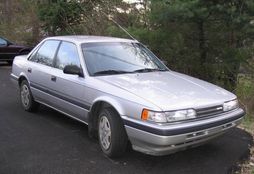


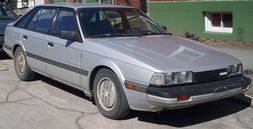




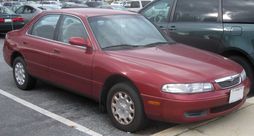
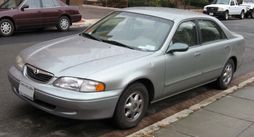
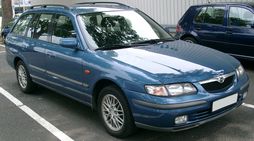
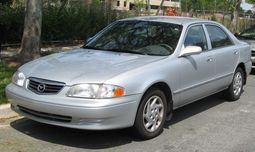

|